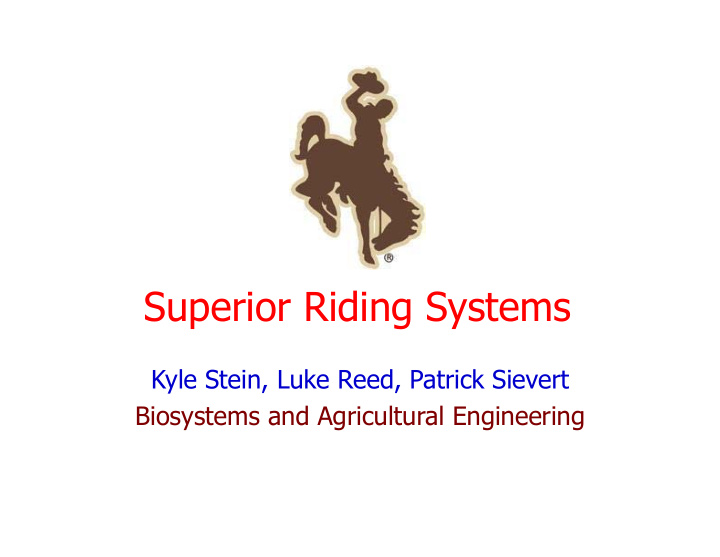



Superior Riding Systems Kyle Stein, Luke Reed, Patrick Sievert Biosystems and Agricultural Engineering
Rockin’ B Bucking Machines Cheyenne, OK Mr. William Beaty Used for television productions, music videos, concert tours, rodeo practice and all kinds of parties
Project Requirements SRS, Superior Riding Systems, has set out to create a versatile mechanical horse simulator Bucking Bronc Riding Simulator Walk Trot Canter
Project Research Rodeo DVD Digital Video of Horse Gaits Personal Experience Horse Gait Analysis
Bucking Broncs
Horse Gaits
Design Criteria Vertical Lift Each of the gaits as well as the buck Naturally created Forward Rocking Created by the horse while in stride Hind quarters creates forward to backward direction Rotational Pitch Created as motion is completed These motions coincide with one another and must be applied in our design to produce the most realistic ride possible.
Final Design Cams to create vertical lift Roll against large cam follower Four-bar linkage Provides vertical lift Provides forward to back rocking motion Pittman arms to create pitch Adjustable length to create varying degrees of pitch Different Modes
Cam Design Cam Design Software Working Model Cams designed to fall at speed of gravity Bucking Cam Seven inches of vertical lift Walk & Canter Cam Smaller, less aggressive versions of bucking cam Trot Cam Three lobes to create rapid bouncing feel
Bucking Mode Pittman arms set so back end is highest when cam is lowest Arms adjusted to longest setting Twelve inches of kick in back end Twenty-two inches of drop in front end
Riding Simulator Canter Mode Arms set so back is highest while body is lowest Smooth rocking motion Walk Mode Toned down version of canter Trot Mode Pittman arms set to zero pitch Strictly vertical motion
Adjustment Between Modes Cam follower shifts to three selectable cams Hydraulic jack raises mechanism Alignment found by pinning holes Pittman arms unlocked and moved to appropriate location
Safety Precautions Shielding of pinch zones Cam shield Brush spool shield Pulley shield Longer body sides Padding of body and lower framework Stabilizer bars
Design Analysis Bearings, motor, gearbox, belt system, shafts sized for high service life. Stress analysis on weakest points prove parts overbuilt 1 1/8” camshaft weakest loaded shaft FOS = 4 at 150 ft-lb motor output torque “H” upper four bar link critical for alignment Torsional deflection at 1500 ft-lb = 1/8” at cam axis Cam life should be further analyzed
Troubleshooting Cam alignment solidified by fixing position of “H” link pillow blocks Sharp edges on body and D rings smoothed Slow ascent on bucking cam Reduce lift on walking cam Future hardening of cams and followers
Final Design Budget Parts list Machining, welding, and assembly $ 1,600 Motors and Gear Boxes $ 2,850 Minor electrical components $ 950 Miscellaneous connectors $ 350 Bearings and power transmission $ 950 Steel $ 400 Total machine estimated cost $ 7,650
Thank You Mr. William Beaty Mr. Jim Friesen Mr. Don Lake Dr. Paul Weckler All BAE staff and faculty Special Thanks To: Wayne Kiner All BAE lab staff
Recommend
More recommend